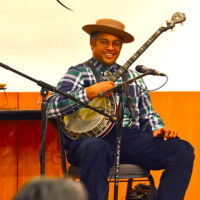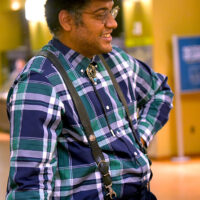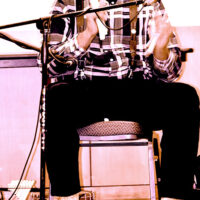
Recently, The American Banjo Museum, the Oklahoma Arts Council, and the Oklahoma History Center partnered to bring Back to our Roots: An exploration of Roots Music to Oklahoma City. The evening was a discussion of the intersections of jazz, blues, roots, and bluegrass music; as well as the influence of race, emancipation, and desegregation on the evolution of music throughout the United States of America.
Dom Flemons has been transplanted from his birthplace, Phoenix, Arizona, to the hills of North Carolina, however, one thing remains clear. His roots are those of the American Songster. At the age of 35, Dom has traversed every genre of music from blues and rock & roll, to jazz and Gospel. And after watching a documentary of the History of Rock & Roll, a segment of the folk revival put a spotlight for him on Bob Dylan. That segment sparked an interest and Dom dug deeper into the folk genre.
Flemons began to see that the reach of his musical fascination included more than just folk music. Not only did Dom desire to learn more about folk traditions, and the styles of old time banjoist Clarence Ashley (1895-1967), he was introduced to the skills of bluegrass artists such as Flatt & Scruggs, setting up an empowerment of knowledge of all genres of music.
With his extremely unique clawhammer variant on a four string banjo, Flemons shares that he spent countless hours researching styles of playing at the local library. “Rhythm can be heard but not seen. I had no idea that to play rhythm on a banjo, you had to have 5 strings.” Flemons picks a 4 string with a double thumbing style. The tuning he uses is also unique for a tenor banjo. The American Songster utilizes an open G tuning, that he picked up from his guitar playing.
Flemons is a mixer, literally blending traditional styles of music with a contemporary approach, creating new sounds to accommodate a wider audience of listeners.
It was in 2005 when Flemons co-founded The Carolina Chocolate Drops, an old time string band. Molding the talents of Rhiannon Giddons, Justin Robinson, and Dom Flemons, this outstanding trio made the climb to the top, opening for Bob Dylan in 2011. But in November 2013, Dom announced he was leaving the CCD to embark on his own solo career, and that he has done.
When discussing the rootball of bluegrass, he said that you can move the music forward as long as you don’t forget the requirements of specific genres, such as the instruments and how they are played. “As long as you have those requirements, you will never get far away from the roots.”
Dom shared his connection with the rhythm bones as well. In 2005, at the Black Banjo Gathering in North Carolina, Cliff Irvin introduced the bones and their history to him. Flemon’s approach to the bones is taken first hand from the history of the minstrel bones. A double fister, Dom shared that Irish music is easier to play with just one set of bones. His background in percussion helped him pattern different styles of rattling the bones.
Since Dom’s music career began with folk music, he soon realized that storytelling is actually part of the traditional way of including historical context. African Americans were in the background of traditional bluegrass, just like every genre of US music. Black minstrel and black vaudeville lays very near to his heart.
Referring Bill Monroe’s classic song Uncle Pen, he mentioned Arnold Schultz, a traveling migrant worker, who played the guitar and fiddle. Schultz, who pioneered the Mecklenberg style of guitar picking, had influenced Monroe and his groundbreaking style of mandolin playing. Dom likes to remind audiences that African American musicians were standing tall, even at the beginnings of bluegrass development. “Music always brings people together, going above cultural barriers,” as Dom put it.
Dressing in the manner of a vaudeville performer is definitely in his bones. Dom is a huge fan of silent movies, and that is where the stage dress of the American Songster began. He attempts to keep his look the same so people will always know what to expect. Donning a plaid shirt, similar to the Kingston Trio wore in the ’60s, was chosen because of the simplicity of colors and ease of purchase from a regular department store. Corduroy pants gave him a dressier appearance versus blue jeans, (cuffed and pleated), but once again, easy to purchase. Plus suspenders and a hat that he first purchased in Australia. He referred to it as a Kubra, the Stetson of Australia. This iconic style sums up Dom Flemons, but after spending several hours with him at the Museum, I found that there was much more to Dom than a plaid shirt, corduroys, suspenders, and an Aussie hat.
This man has his own rootball and he is sticking to those roots.










